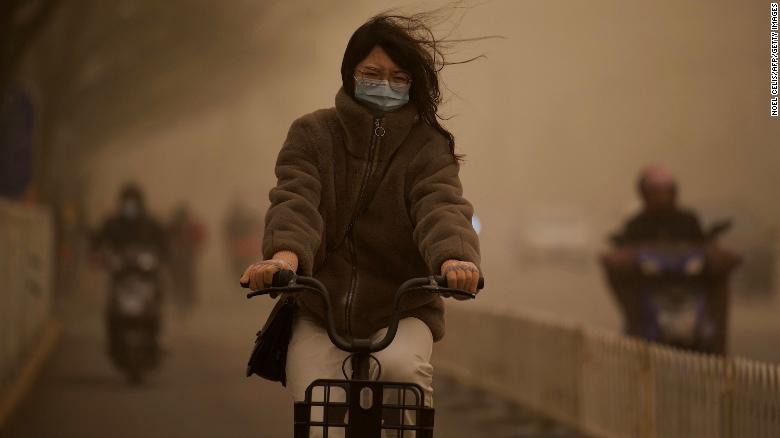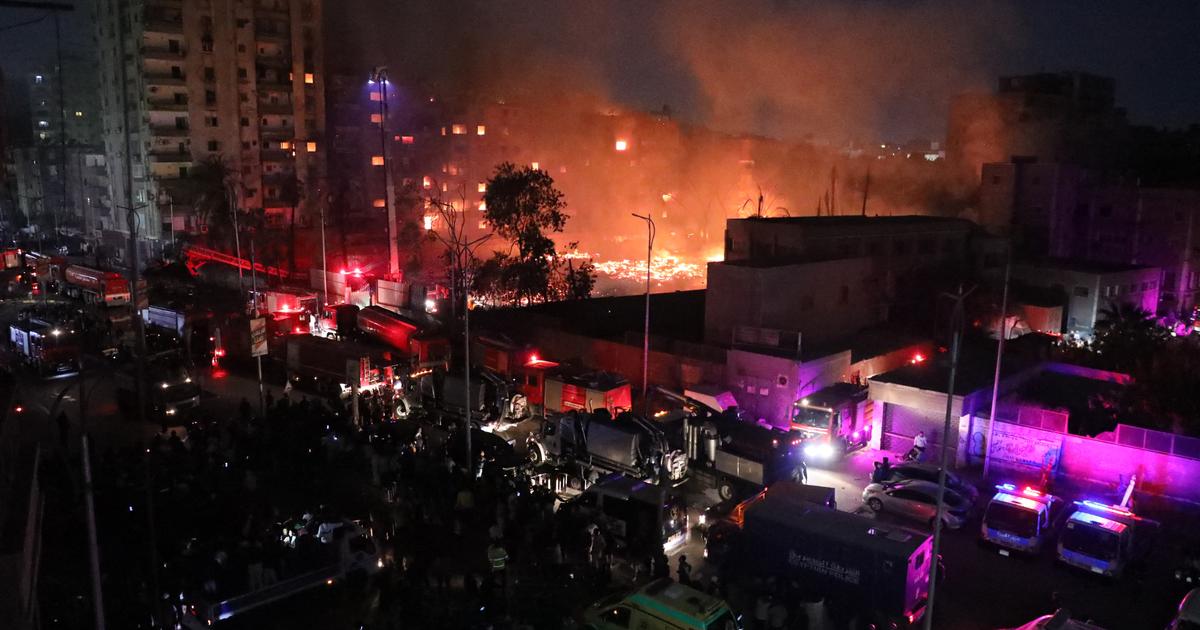Cars on a highway amid a sandstorm during morning rush hour in Beijing, China, on March 15, 2021.
(CNN) -
China's capital was drowning in sand and dust on Monday when the largest sandstorm in nearly a decade hit the city, turning the sky a mysterious shade of orange.
Photos from Beijing, home to 21.7 million residents, show skyscrapers and cars shrouded in thick haze.
Air quality indexes are rated "dangerous" and authorities advise residents to stay indoors.
However, many workers braved the weather conditions and walked or biked through the strong sandy winds.
Visibility was so bad in parts of the city that drivers had to turn on their lights, even though it was noon.
LOOK: What is it like to drive in a sandstorm?
"In some places, there are strong sandstorms with a visibility of less than 500 meters," the China Meteorological Administration said in a statement on Monday.
"This is also the strongest dust and sand climate to hit China in nearly 10 years."
Air quality in Beijing
Air quality in Beijing was already bad due to high levels of pollution.
When the sandstorm hit, the city's air quality plummeted to dangerous levels, according to the World Air Quality Index.
A woman rides a bicycle on a street during a sandstorm in Beijing, China, on March 15, 2021.
The index measures the concentration of different pollutants in the air, the most important being PM2.5.
This harmful microscopic particulate material is less than 2.5 microns in diameter and is considered particularly dangerous as it can lodge deep in the lungs and pass to other organs and into the bloodstream.
advertising
Beijing measured a maximum of 655 micrograms per cubic meter on Monday.
The World Health Organization considers anything above 25 to be unsafe.
The origin of the new sandstorm
The sandstorm originated in Mongolia, where six people were killed and 81 are missing, according to Chinese state media The Paper.
From Mongolia, the sandstorm gradually moved south.
Beijing saw concentrations of the largest PM 10 particles exceeding 8,100 micrograms per cubic meter, according to the city's Environmental Monitoring Center.
This prompted the Central Meteorological Observatory to issue a yellow alert for sandstorms.
It is the second level in a four-level color-coded weather alert system.
Authorities advised the public to avoid going outside if possible.
And the Beijing Municipal Education Commission on Monday called on schools and education committees to suspend outdoor activities.
Buildings in Beijing's central business district are covered in heavy haze during a sandstorm on March 15, 2021.
The frequency of sandstorms in China decreases
Sand storms used to occur regularly in spring.
In past decades, at least two rounds of sandstorms have occurred each May, according to the state-run Xinhua news agency.
The frequency and severity of the sandstorms was due in part to drought, increasing population pressure, and limited progress in revegetation, which led to rapid land desertification in the north and northwest.
But the sandstorms have drastically subsided since then.
The annual number of days affected by sandstorms in Beijing fell from a high of 26 in the 1950s to just three days after 2010, Xinhua reported.
Since 2000, the Chinese government has invested billions of dollars in sandstorm prevention.
Authorities have launched several ecological and reforestation projects, and installed satellites to monitor sandstorms and alert meteorological agencies in advance.
Sandstorms also hit northern Hebei and Shanxi provinces, western Gansu and central and western Inner Mongolia on Monday, Xinhua said.
Other parts of the country, including northern Xinjiang, experience high levels of wind gusts.
The sandstorms are expected to last through Tuesday.
Mongolia, which is located north of China, is experiencing strong cyclones, the Meteorological Administration said.
Sand and dust from Mongolia have moved east and south over northern regions of China, carried away by the high cold pressure in the rear of the cyclone.
Beijing sandstorm



/cloudfront-eu-central-1.images.arcpublishing.com/prisa/QYARZLICO47BA5G6YE4UUN26IQ.jpg)




